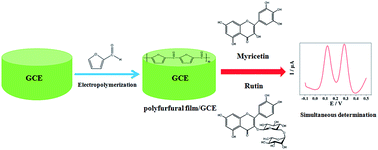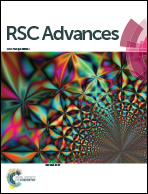High sensitivity simultaneous determination of myricetin and rutin using a polyfurfural film modified glassy carbon electrode
Abstract
In this work, we successfully develop a simple electrochemical sensor based on a polyfurfural film modified glassy carbon electrode to realize the simultaneous electrochemical determination of myricetin and rutin. The proposed sensor exhibits superior electrocatalytic activity to both myricetin and rutin, simultaneously demonstrating a wide linear detection range of 0.05–10 μmol dm−3 with a low detection limit of 10 ± 0.5 nmol dm−3 (S/N = 3, α = 0.05, n = 3, type I error) for myricetin, and linear detection range of 0.001–10 μmol dm−3 with a low detection limit of 0.025 ± 0.004 nmol dm−3 (S/N = 3, α = 0.05, n = 3, type I error) for rutin. With favorable selectivity, stability and reproducibility, the proposed sensor was satisfied by applying for simultaneous determination of myricetin and rutin in real samples. It may provide a new strategy to simultaneously determine different kinds of polyphenolic compounds with polyfurfural film modified glassy carbon electrode in application of pharmaceutical and biological analysis in the future.


 Please wait while we load your content...
Please wait while we load your content...